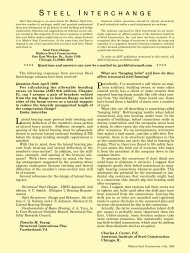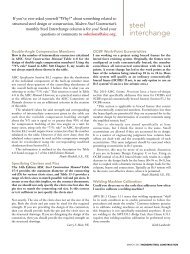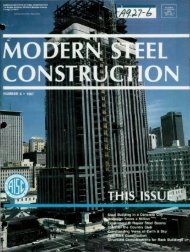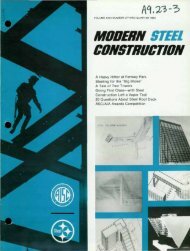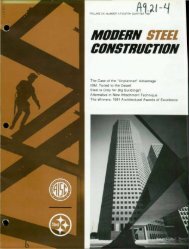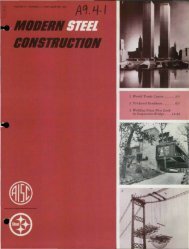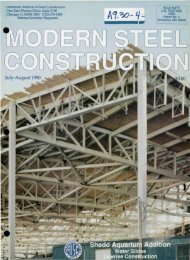what every steel erector should know about welding ... - AISC
what every steel erector should know about welding ... - AISC
what every steel erector should know about welding ... - AISC
Create successful ePaper yourself
Turn your PDF publications into a flip-book with our unique Google optimized e-Paper software.
ple, of <strong>welding</strong> processes (e.g.,<br />
FCAW vs. SMAW), visual acceptance<br />
criteria, joint and weld<br />
types (e.g., butt joint with a single-bevel<br />
groove weld), joint fitup<br />
tolerances, and position (e.g.,<br />
2F and 6G).<br />
QUALITY CONTROL<br />
If <strong>welding</strong> is required, is a<br />
competent <strong>welding</strong> technician<br />
(such as a CWI or<br />
ACWI) employed by the<br />
applicant? (<strong>AISC</strong>,<br />
Advanced Program Only —<br />
Mg166)<br />
“Erector had no <strong>welding</strong><br />
inspector.”<br />
It is important to have personnel<br />
available to the job site who<br />
have training in <strong>welding</strong>, including<br />
the AWS D1 Welding Codes,<br />
<strong>welding</strong> processes, inspection<br />
technology and quality acceptance<br />
criteria. The Certified<br />
Welding Inspector (CWI) program<br />
sponsored by AWS<br />
requires the participants to<br />
demonstrate their <strong>know</strong>ledge of<br />
these issues through job experience<br />
and examination. Having a<br />
CWI on staff is no guarantee<br />
against problems, but it does<br />
provide some level of confidence<br />
when trouble arises. The D1.1<br />
Code does not require a AWS<br />
CWI; there are other acceptable<br />
qualification bases such as the<br />
Canadian Welding Bureau CWI<br />
(AWS D1.1-98, para. 6.1.4.1).<br />
Since quality is a core objective<br />
of the <strong>AISC</strong> Erector Certification<br />
Program, incorporating qualified<br />
people is fundamental. A CWI is<br />
not essential to obtaining a certificate<br />
but there must be someone<br />
available who has demonstrated<br />
awareness of <strong>welding</strong><br />
and code issues.<br />
Are job site superintendents<br />
and foremen conversant<br />
with current workmanship<br />
requirements<br />
such as those contained in<br />
AWS, AREA, <strong>AISC</strong>,<br />
AASHTO, specifications?<br />
(<strong>AISC</strong>, Op17)<br />
“The <strong>welding</strong> foreman did not<br />
<strong>know</strong> <strong>what</strong> the AWS D1.1 Code<br />
was.”<br />
No one expects the job superintendent<br />
or the foreman to<br />
<strong>know</strong> all the applicable code provisions<br />
from memory, but they<br />
<strong>should</strong> at least <strong>know</strong> <strong>what</strong> the<br />
code is and where to find<br />
answers to common code questions.<br />
For example, the auditor<br />
may ask the foreman to show<br />
him the code provisions for<br />
allowable porosity levels. The<br />
foreman <strong>should</strong> be able to fairly<br />
quickly open the AWS D1.1 Code<br />
and turn to Chapter 6 -<br />
Inspection to find the answer.<br />
Has a key person been<br />
assigned the responsibility<br />
of bolting or <strong>welding</strong> joints<br />
in accordance with the<br />
applicable specifications?<br />
(<strong>AISC</strong>, Op30)<br />
“No one knew who was in<br />
charge of <strong>welding</strong>.”<br />
At the heart of this requirement<br />
are two issues: responsibility<br />
and specifications. To<br />
achieve high quality, key people<br />
must ensure that the work conforms<br />
to the standards established<br />
in the specifications (e.g.,<br />
AWS D1.1 and contract documents).<br />
Along with responsibility<br />
must come the motivation to<br />
do the right thing and to see<br />
things through to completion.<br />
Responsibility also encourages<br />
pride of workmanship, ownership,<br />
the understanding that it<br />
has to be done correctly and that<br />
it is up to the individual to<br />
accomplish the goal. This person<br />
can be the one responsible for<br />
assuring quality of the work, but<br />
he must <strong>know</strong> the criteria and be<br />
active on the site. If this responsibility<br />
is not given to one specific<br />
person, the likelihood of conformance<br />
to the workmanship<br />
standards in the specifications is<br />
low. The person in charge of<br />
<strong>welding</strong> must also have the<br />
authority to make decisions.<br />
There is little benefit in giving<br />
responsibility to someone who<br />
can not authorize the work to be<br />
done.<br />
Do the welders understand,<br />
comply with, and<br />
check their welds against<br />
the workmanship and<br />
technique requirements of<br />
<strong>AISC</strong>, AASHTO, or AWS?<br />
(<strong>AISC</strong>, Op35)<br />
“The welder was making welds<br />
with unacceptable undercut and<br />
didn’t <strong>know</strong> <strong>what</strong> was wrong.”<br />
The Code says that, “the contractor<br />
shall be responsible for<br />
visual inspection and necessary<br />
correction of all deficiencies in<br />
materials and workmanship in<br />
accordance with the requirements<br />
of this code” (AWS D1.1-<br />
98, para. 6.6.1). This includes<br />
the following issues: cracks,<br />
weld/base metal fusion, craters,<br />
weld profiles, weld size, undercut,<br />
and porosity (AWS D1.1-98,<br />
Table 6.1). This code provision<br />
establishes the basis for the<br />
requirement that the welders<br />
must “understand, comply with,<br />
and check” their work.<br />
According to the auditor’s note<br />
in this example, the welder<br />
apparently didn’t <strong>know</strong> <strong>what</strong><br />
undercut was, or that there were<br />
unacceptable limits. Since the<br />
contractor is responsible for visual<br />
inspection, having the welders<br />
check to make sure that their<br />
work meets the visual inspection<br />
criteria is an effective first step.<br />
WELDER QUALIFICATION<br />
Does the applicant have a<br />
record of the craft workers<br />
who are certified welders?<br />
(<strong>AISC</strong>, Mg7c)<br />
“No Welder Performance<br />
Qualification Records (WPQRs)<br />
were available.”<br />
In this example, records were<br />
inadequate to prove the qualification<br />
of the welders. AWS D1.1<br />
states that “the Welding<br />
Performance Qualification<br />
Modern Steel Construction / May 1999



